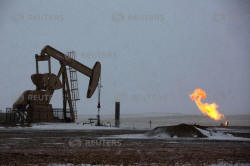|
U.S. oil producers ramped up production in the nation's
third-largest oilpatch, boosting crude output to a record 1.3
million barrels per day (bpd) in October, overwhelming pipelines
and rail cars.
The region's pipeline capacity is just 1.25 million bpd, per
market intelligence firm Genscape, forcing producers in North
Dakota to rely on less efficient rail, which could face
difficulties operating in the winter. In addition, nearby
Canadian producers also grappling with bottlenecks are pushing
more oil into the United States, worsening the constraints.
Bakken crude traded at a record $20-per-barrel discount to U.S.
crude futures <WTC-BAK> last week, and last traded at a
$13.50-per-barrel discount on Friday.
Refinery maintenance exacerbated the discounts but as work wraps
up, prices could find some support, company executives said.
Discounts on Bakken oil are nothing new, due to capacity
constraints that forced refiners to rely on rail. The startup of
Energy Transfer's Dakota Access pipeline in 2017 changed that,
but record production is straining capacity again.
"That basin is flush with barrels and there's no way out," Rick
Hessling, senior vice president at U.S. refiner Marathon
Petroleum Corp, said in an earnings call last week, adding that
winter will make rail loadings more difficult. "We kind of see
that as a perfect storm."
Dakota Access pipeline was full in October, according to
Genscape's latest data, while one of the other major lines had
an 85 percent utilization rate.
North Dakota's crude production typically is not affected enough
to lift prices the winter, but rail operations face severe
challenges in the frigid weather, said John Zanner, crude
analyst at RBN Energy.
"Winter weather makes crude-by-rail operations much more
difficult. You have stuff freeze up, especially in North
Dakota," Zanner said.
Energy Transfer LP <ET.N> plans to expand the Dakota Access
pipeline system to as much as 570,000 bpd from about 525,000 bpd
currently.
New pipeline and refining projects have been announced, but
takeaway capacity will remain tight in the near-term as they get
completed, analysts said. That is more apparent after a judge
halted construction on the Keystone XL pipeline from Canada,
potentially adding to a supply glut.
Several Canadian producers have already announced production
cuts due to bottlenecks, but that is not enough. "We're going to
need curtailment and higher rail capacity," one trader at a
merchant said.
(Reporting by Devika Krishna Kumar in New York and Collin Eaton
in Houston; editing by Diane Craft)
[© 2018 Thomson Reuters. All rights
reserved.] Copyright 2018 Reuters. All rights reserved. This material may not be published,
broadcast, rewritten or redistributed.
Thompson Reuters is solely responsible for this content.
 |
|




